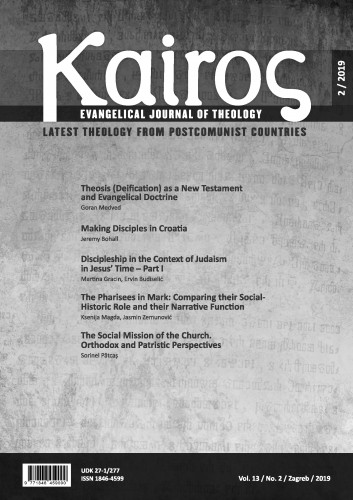The usage of the terms “disciple” and “discipleship” are very common among evangelical Christians and meanings of these terms seem self-evident. However, although these circles adopted such language, it was already present in the Jewish culture of Jesus’ time. The purpose and the goal of this article is to analyze the concept of discipleship in its original context and see how much the meaning of this term is removed from the meaning that this term has today. This topic we will address in two parts. In the first chapter, we will study the Old Testament (OT) roots of discipleship, and in the second chapter, the Jewish educational system in Jesus’ time. In the third chapter, we will analyze whether Jesus himself, and in what measure, passed through that Jewish educational system, and how and in what ways he used this model in the discipleship process of his disciples. In the second part of the article, we will address the practice of discipleship in the first Church, and after that offer some guidelines on how to apply Jesus’ concept of discipleship in the Church today. The key focus of this article is the problematic of applying principles of discipleship that were present in the context of Jewish culture, on the Church today, since our analysis reveals that understanding of discipleship today does not correspond entirely to the understanding of that concept in Jesus’ time. Although discipleship then and now contained passing on information, more importantly was to follow the rabbi and learn from him in a close relationship. It is concluded that a possible solution for this challenge must be sought first and foremost in the change of thinking about what discipleship truly is (change of focus), and then in the practice through mentoring or working in small groups purposefully expose both sides (both “teachers” and “students”) to the experience of teaching through example.; Upotreba pojmova učenik i učeništvo vrlo je uobičajena u evanđeoskom kršćanstvu, i značenje tih pojmova smatra se samo po sebi razumljivim. Međutim, iako je u tim krugovima došlo do svojevrsnog posvajanja ovoj pojma, on je već ranije postojao i u židovskoj kulturi Isusovog vremena. Svrha i cilj ovog članka je proučiti značenje koncepta učeništva u njegovom originalnom kontekstu, i vidjeti koliko to značenje odudara od značenja koje taj pojam ima danas. Ovu temu obradit ćemo u dva dijela. U prvome poglavlju proučavaju se starozavjetni korijeni koncepta učeništva, a u drugom poglavlju sagledava se židovski sustav obrazovanja u Isusovom vremenu. U trećem poglavlju razmatra se je li i sam Isus, i u kojoj mjeri, prošao kroz taj židovski sustav obrazovanja, te kako i na koji je način Isus koristio taj model u poučavanju svojih učenika. U drugome dijelu članka prvo ćemo razmotriti praksu učeništva u prvoj Crkvi, a nakon toga ponuditi smjernice za primjenu Isusovog koncepta učeništva danas u Crkvi. Ključni fokus ovog članka je na problematici prenošenja principa učeništva shvaćenih unutar konteksta židovske kulture na Crkvu danas, budući da istraživanje otkriva kako razumijevanje tog pojma danas ne odgovara sasvim načinu na koji se shvaćalo učeništvo u Isusovo doba. Naime, premda je učeništvo i onda sadržavalo prenošenje informacija, važnije od toga je bilo slijediti učitelja (rabina), i učiti od njega u bliskom odnosu. U članku se zaključuje da moguće rješenje za ovaj izazov treba potražiti najprije u promjeni razmišljanja o tome što učeništvo uistinu jest (promjena fokusa), a onda u praksi kroz mentorstvo i male grupe ciljano izložiti obje strane (i „učitelja“ i „učenika“) iskustvu poučavanja primjerom.
Sažetak

 Kairos : evangelical journal of theology 13,2(2019) / editor Stanko Jambrek.
Kairos : evangelical journal of theology 13,2(2019) / editor Stanko Jambrek.